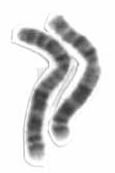Chromosome 2 is one of the 23 pairs of chromosomes in humans. People normally have two copies of this chromosome. Chromosome 2 is the second-largest human chromosome, spanning more than 242 million base pairs (the building material of DNA) and representing almost 8% of the total DNA in human cells.
Identifying genes on each chromosome is an active area of genetic research. Because researchers use different approaches to genome annotation their predictions of the number of genes on each chromosome varies. In January 2017, two estimates differed by 12%, with one estimate giving 3,862 genes, and the other estimate giving 3,399 genes.
Chromosome had the HOXD homeobox gene cluster.
All members of Hominidae except humans, Neanderthals, and Denisovans have 24 pairs of chromosomes. Humans have only 23 pairs of chromosomes. Human chromosome 2 is a result of an end-to-end fusion of two ancestral chromosomes.
The evidence for this includes:
The correspondence of chromosome 2 to two ape chromosomes. The closest human relative, the chimpanzee, has near-identical DNA sequences to human chromosome 2, but they are found in two separate chromosomes. The same is true of the more distant gorilla and orangutan.
The presence of a vestigial centromere. Normally a chromosome has just one centromere, but in chromosome 2 there are remnants of a second centromere in the q21.3–q22.1 region.
The presence of vestigial telomeres. These are normally found only at the ends of a chromosome, but in chromosome 2 there are additional telomere sequences in the q13 band, far from either end of the chromosome.
According to researcher J. W. IJdo, "We conclude that the locus cloned in cosmids c8.1 and c29B is the relic of an ancient telomere-telomere fusion and marks the point at which two ancestral ape chromosomes fused to give rise to human chromosome 2."
Among the genes located on chromosome 2 are these:
ACTR1B: encoding protein Beta-centractin
ACTR2: encoding protein Actin-related protein 2
ADI1: encoding enzyme 1,2-dihydroxy-3-keto-5-methylthiopentene dioxygenase
AFF3: encoding protein AF4/FMR2 family member 3
AFTPH: encoding protein Aftiphilin
AGXT: alanine-glyoxylate aminotransferase (oxalosis I; hyperoxaluria I; glycolicaciduria; serine-pyruvate aminotransferase)
ALS2: amyotrophic lateral sclerosis 2 (juvenile)
ALS2CR8: encoding protein Amyotrophic lateral sclerosis 2 chromosomal region candidate gene 8 protein also known as calcium-response factor (CaRF)
ARMC9: encoding protein LisH domain-containing protein ARMC9
C2orf18: encoding protein Transmembrane protein C2orf18
C2orf28: encoding protein Apoptosis-related protein 3
COL3A1: collagen, type III, alpha 1 (Ehlers-Danlos syndrome type IV, autosomal dominant)
COL4A3: collagen, type IV, alpha 3 (Goodpasture antigen)
COL4A4: collagen, type IV, alpha 4
COL5A2: collagen, type V, alpha 2
CTLA4: cytotoxic T-Lymphocyte Antigen 4
HADHA: hydroxyacyl-Coenzyme A dehydrogenase/3-ketoacyl-Coenzyme A thiolase/enoyl-Coenzyme A hydratase (trifunctional protein), alpha subunit
HADHB: hydroxyacyl-Coenzyme A dehydrogenase/3-ketoacyl-Coenzyme A thiolase/enoyl-Coenzyme A hydratase (trifunctional protein), beta subunit
NCL: Nucleolin
NR4A2: nuclear receptor subfamily 4, group A, member 2
OTOF: otoferlin
PAX3: paired box gene 3 (Waardenburg syndrome 1)
PAX8: paired box gene 8
PELI1: Ubiquitin ligase
RPL37A: encoding protein 60S ribosomal protein L37a
SATB2: Homeobox 2
SLC40A1: solute carrier family 40 (iron-regulated transporter), member 1
SSB: Sjogren syndrome antigen B
TPO: thyroid peroxidase
TTN: titin
Genes located on the short arm of this chromosome include
ALMS1
ABCG5 and ABCG8: ATP-binding cassette, subfamily A, members 5 and 8
MSH2: mutS homolog 2, colon cancer, nonpolyposis type 1 (E. coli)
MSH6: mutS homolog 6 (E. coli)
TTC7A: familial multiple intestinal atresia
WDR35 (IFT121: TULP4): intraflagellar transport 121
CCDC142: Coiled-Coil Domain Containing 142
Genes located on the long arm of this chromosome include
ABCA12: ATP-binding cassette, sub-family A (ABC1), member 12
BMPR2: bone morphogenetic protein receptor, type II (serine/threonine kinase)
TBR1: T-box, brain, 1
The following diseases and traits are related to genes located on chromosome 2:
2p15-16.1 microdeletion syndrome
Autism
Alport syndrome
Alström syndrome
Amyotrophic lateral sclerosis
Amyotrophic lateral sclerosis, type 2
Congenital hypothyroidism
Crigler-Najjar types I/II
Dementia with Lewy bodies
Ehlers–Danlos syndrome
Ehlers–Danlos syndrome, classical type
Ehlers–Danlos syndrome, vascular type
Fibrodysplasia ossificans progressiva
Gilbert's Syndrome
Harlequin type ichthyosis
Hemochromatosis
Hemochromatosis type 4
Hereditary nonpolyposis colorectal cancer
Infantile-onset ascending hereditary spastic paralysis
Juvenile primary lateral sclerosis
Long-chain 3-hydroxyacyl-coenzyme A dehydrogenase deficiency
Maturity onset diabetes of the young type 6
Mitochondrial trifunctional protein deficiency
Nonsyndromic deafness
Nonsyndromic deafness, autosomal recessive
Primary hyperoxaluria
Primary pulmonary hypertension
Sitosterolemia (knockout of either ABCG5 or ABCG8)
Sensenbrenner syndrome
SATB2 Associated syndrome
Synesthesia
Waardenburg syndrome

